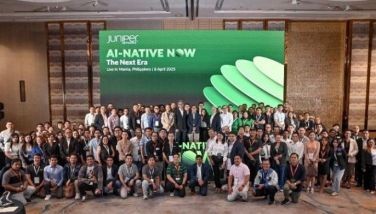The art of making super sushi
MANILA, Philippines -Simple, straightforward ingredients transformed into superlative sushi. It is just wonderful how the most basic food elements can be turned into the most delectable tidbits. “The crucial factor, of course, has to be freshness,” says chef Andy Matsuda. In his skilled hands, everyday ingredients quickly take new form as the most delightful and artistic morsels.
Preparing the sushi rice is easy but the amount of vinegar and sugar added depends on personal taste. To be on the safe side, however, the sushi expert advises, “Remember this ratio: 7 measures vinegar, 5 measures sugar and 2 measures of sea salt.” This is to flavor the short-grained sushi rice. While the best rice is considered to be shinmai, newly hulled rice that is used within three months after harvest, any short- grained variety will suffice. The use of kombu dashi or kelp soaked in water for cooking the rice will also lend a nice umami taste.
“Nowadays there is no limit to what kind of short-grain rice variety is used,” says Andy. With the upsurge in healthy food choices, he notes that even brown rice varieties are employed. Sushi has in fact become so popular all over the world that new variants are continuously being created. However, “one tip is to mix the rice and vinegar in a wooden bowl to avoid the chemical reactions that could occur when you use a metal pot,” he advises.
But how does one become a master sushi chef? Although his parents owned a restaurant and he was required to help in the kitchen from the time he was nine years old, Andy admits to starting out with mediocre sushi skills. He relates, “When I was 18 years old my father brought me to the restaurant of his friend who wanted to test me. They both gave me shrimp to work on. And when I was done, they laughed at the results. I told them, ‘Give me one year and I will show you. ’ I went to Osaka and worked harder than everyone else.” When he came back, they were truly impressed.
Chef Andy’s training included apprenticeships with some of Osaka’s most famous chefs. “Sushi as we did it was very traditional,” he recalls. He became a member of the prestigious sushi chef organization called Yosei-kai. This was followed by a 10-year stint in the United States working for a hotel. Then he got sick at age 36. “A bout with colon cancer forced me to stop working so that I could take care of myself. It was then that I fully realized that it was important for everyone to eat healthy food.”
Having recovered from his illness in 2002, Andy decided to put up the Sushi Chef Institute in Los Angeles, California. “When I got sick, it was the American insurance system that helped me. This was my way of giving back,” he continues. “Fresh raw food prepared correctly is healthy. It has no butter, eggs, heavy creams or ingredients with preservatives.”
“Sushi is very diverse, very global,” he observes. “There may be many sushi bars but there is always room for more. At the Sushi Chef Institute, I encourage students to learn the traditional methods, and at the same time, discover new aspects of sushi-making.” Apart from the ability to adeptly handle a knife, he stresses the importance of cleanliness and discipline in the kitchen. “Hygiene and food safety is very important and a main part of the education is instilling the need to constantly keep things clean. Needless to say, you surely won’t find people smoking in the kitchen.”
About a thousand students from around the world (including three Filipino citizens) have completed the two-month intensive training course and have set up restaurants in many countries.
“Anyone with enough interest can learn the art of sushi.” Now in his 50s, chef Andy is convinced that “sushi-making is very personal. It is a matter of trust. Working with fresh food helps you to develop a profound appreciation of nature. The core of my teaching philosophy is based on my profound appreciation of nature, family and society. One has to do his share for the environment to be able to have a continuous supply of safe, healthful ingredients.”




















